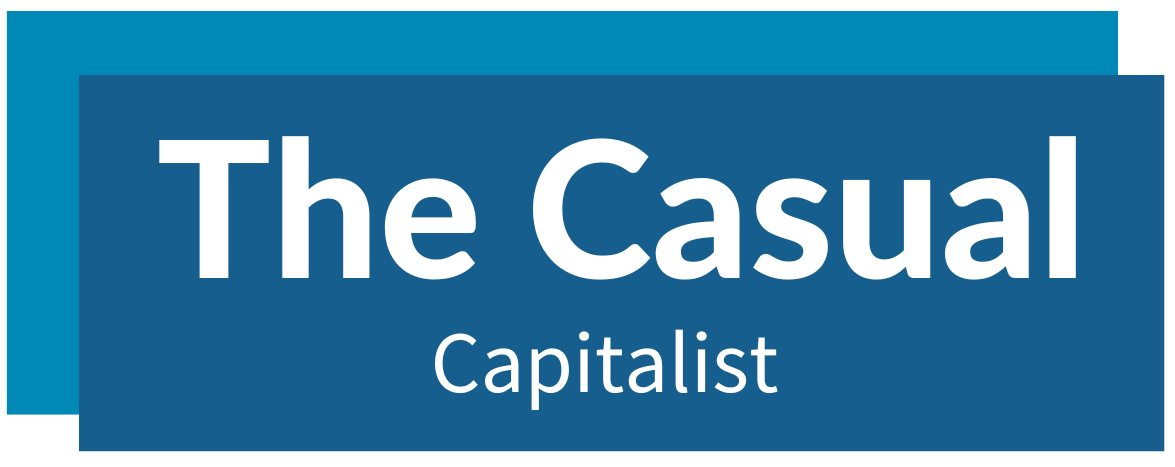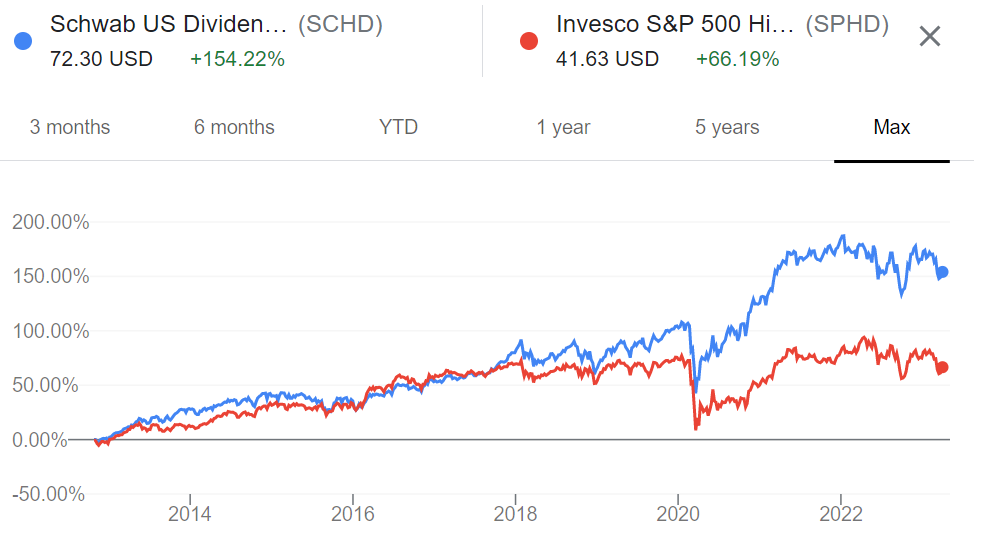Schwab’s Dividend ETF SCHD has caught a lot of attention in the past couple of years for outperforming S&P 500 ETFs while ALSO providing a larger dividend than the S&P 500.
But with volatility increasing Post-Covid, investors are in search safety and many have been looking for low volatility Dividend ETFs like SPHD.
In this article, we will compare two popular dividend ETFs, SCHD and SPHD, to help you decide which one is a better fit for your investment strategy.
| Key Characteristics | SCHD | SPHD |
|---|---|---|
| YTD Return | -3.77% | -4.62% |
| 1Y Return | -5.73% | -8.49% |
| 5Y Return (Ann) | 11.68% | 5.35% |
| 10Y Return (Ann) | 11.93% | 8.41% |
| Sharpe Ratio | -0.31 | -0.46 |
| Daily Std Dev | 18.72% | 18.61% |
| Max Drawdown | -33.37% | -41.39% |
SCHD the Basics
SCHD stands for Schwab U.S. Dividend Equity ETF. This ETF tracks the Dow Jones U.S. Dividend 100 Index, which is composed of 100 high-quality U.S. stocks that have a record of consistently paying dividends. SCHD has a low expense ratio of just 0.06%, making it an attractive option for investors looking to minimize costs.
SPHD the Basics
SPHD stands for Invesco S&P 500 High Dividend Low Volatility ETF. This ETF tracks the S&P 500 Low Volatility High Dividend Index, which is composed of 50 high-yield U.S. stocks that have a record of consistently paying dividends. SPHD has a slightly higher expense ratio of 0.3%, but it also offers a higher dividend yield than SCHD.
SCHD vs SPHD Top Holdings
SCHD, or the Schwab U.S. Dividend Equity ETF, tracks a market-cap-weighted index of high-dividend-yielding U.S. stocks. Its objective is to provide exposure to U.S. companies with a history of consistently paying dividends.
SPHD, or the Invesco S&P 500 High Dividend Low Volatility ETF, seeks to track the performance of the S&P 500 Low Volatility High Dividend Index. This index is designed to measure the performance of 50 high-yielding, low-volatility stocks in the S&P 500 Index.
Both SCHD and SPHD focus on high dividend-yielding stocks, but they differ in their selection criteria. SCHD seeks out companies with a consistent history of paying dividends, while SPHD focuses on stocks that exhibit both high dividends and low volatility.
In terms of specific holdings, as of September 2021, SCHD’s top ten holdings included companies such as Johnson & Johnson, Procter & Gamble, and PepsiCo, while SPHD’s top ten holdings included companies such as AT&T, Duke Energy, and Verizon.
SCHD vs SPHD Top Sectors
As of September 2021, the top sectors for SCHD were Consumer Staples, Healthcare, and Information Technology. Consumer Staples made up 23.4% of the portfolio, Healthcare 20.4%, and Information Technology 14.7%.
On the other hand, the top sectors for SPHD were Utilities, Consumer Staples, and Real Estate. Utilities made up 22.6% of the portfolio, Consumer Staples 20.8%, and Real Estate 16.5%.
While there is some overlap in the sectors between the two ETFs, there are also some differences. SCHD has a higher allocation to the Information Technology sector, while SPHD has a higher allocation to the Utilities and Real Estate sectors.
| SCHD Top 10 Holdings | Weighting |
|---|---|
| AbbVie, Inc. | 4.29% |
| Texas Instruments Incorporated | 4.23% |
| PepsiCo, Inc. | 4.19% |
| Cisco Systems, Inc. | 4.19% |
| Broadcom Inc. | 4.18% |
| United Parcel Service, Inc. Class B | 4.16% |
| Pfizer Inc. | 4.14% |
| Coca-Cola Company | 4.12% |
| Verizon Communications Inc. | 4.12% |
| Home Depot, Inc. | 4.03% |
| Total Top 10 Weighting | 41.64% |
| SPHD Top 10 Holdings | Weighting |
|---|---|
| Altria Group, Inc. | 3.27% |
| AT&T Inc. | 3.23% |
| Verizon Communications Inc. | 3.05% |
| Kinder Morgan Inc Class P | 2.76% |
| International Paper Company | 2.51% |
| Dow, Inc. | 2.48% |
| Simon Property Group, Inc. | 2.43% |
| Williams Companies, Inc. | 2.37% |
| Pinnacle West Capital Corporation | 2.35% |
| Walgreens Boots Alliance, Inc. | 2.34% |
| Total Top 10 Weighting | 26.77% |
| SCHD | Segment | Benchmark |
|---|---|---|
| Health Technology | 16.43% | — |
| Electronic Technology | 16.12% | — |
| Finance | 13.99% | — |
| Consumer Non-Durables | 13.30% | — |
| Energy Minerals | 8.12% | — |
| Retail Trade | 5.10% | — |
| Producer Manufacturing | 4.21% | — |
| Transportation | 4.16% | — |
| Communications | 4.12% | — |
| Technology Services | 3.98% | — |
| SPHD | Segment | Benchmark |
|---|---|---|
| Finance | 26.93% | — |
| Utilities | 17.27% | — |
| Consumer Non-Durables | 10.91% | — |
| Process Industries | 8.78% | — |
| Health Technology | 6.58% | — |
| Communications | 6.28% | — |
| Commercial Services | 3.43% | — |
| Electronic Technology | 3.08% | — |
| Industrial Services | 2.76% | — |
| Energy Minerals | 2.37% | — |
Performance
When it comes to performance, both SCHD and SPHD have delivered impressive returns over the past five years. SCHD has returned an annualized rate of 12.06%, while SPHD has returned an annualized rate of 11.25%. However, it is important to note that past performance is not a guarantee of future results.
Expense Ratio and Fees
As mentioned earlier, SCHD has a lower expense ratio of 0.06% compared to SPHD’s expense ratio of 0.3%. This means that SCHD is a more cost-effective option for investors who are looking to minimize fees and expenses.
Dividend Yield
One of the main reasons why investors opt for dividend ETFs is for their high dividend yields. SPHD has a higher dividend yield of 5.56% compared to SCHD’s dividend yield of 3.08%. However, it is important to note that a higher dividend yield does not necessarily mean a better investment option. Investors should consider their investment goals and risk tolerance before making a decision based solely on dividend yield.
| Period | TTM | 2022 | 2021 | 2020 | 2019 | 2018 | 2017 | 2016 | 2015 |
|---|---|---|---|---|---|---|---|---|---|
| SCHD | 4.38% | 3.42% | 2.90% | 3.40% | 3.33% | 3.53% | 3.12% | 3.53% | 3.74% |
| SPHD | 5.18% | 3.93% | 3.63% | 5.33% | 4.67% | 5.27% | 3.92% | 4.94% | 4.68% |
Which ETF Wins?
To sum up, both SCHD and SPHD offer unique advantages and disadvantages for investors. SCHD is more diversified, has a lower expense ratio, and has a solid track record of delivering consistent returns.
SPHD, on the other hand, offers a higher dividend yield and a more concentrated portfolio. Ultimately, the choice between these two ETFs comes down to your investment goals and risk tolerance.

